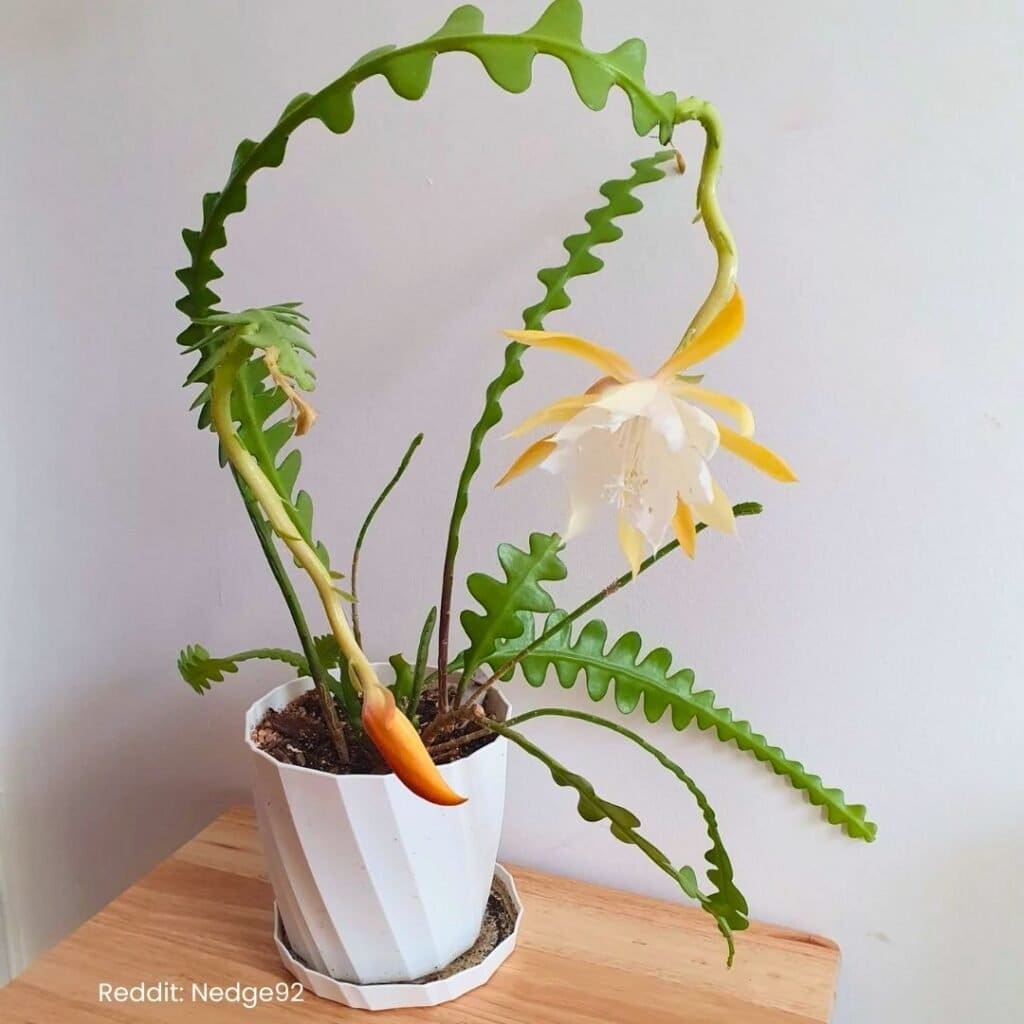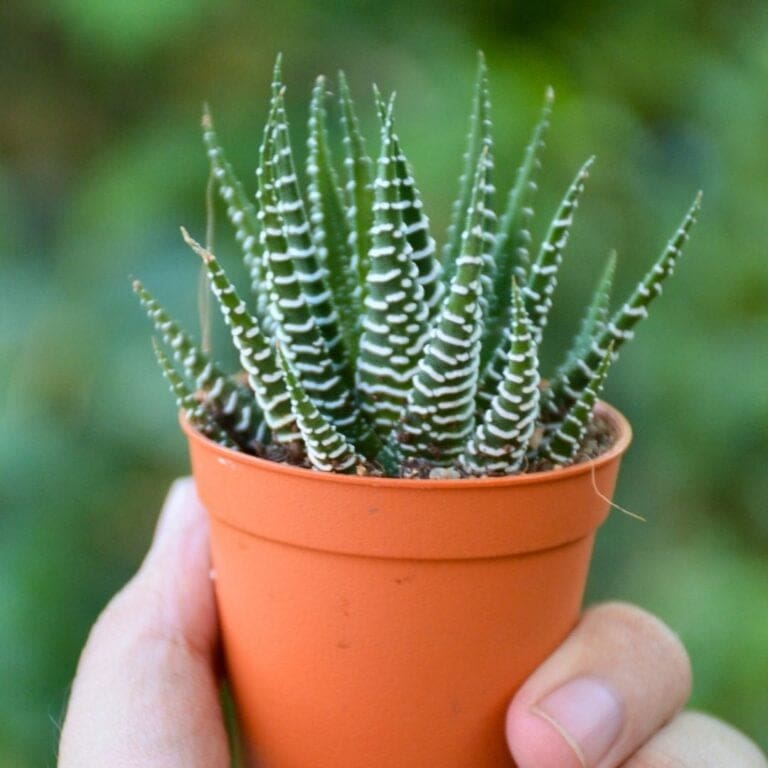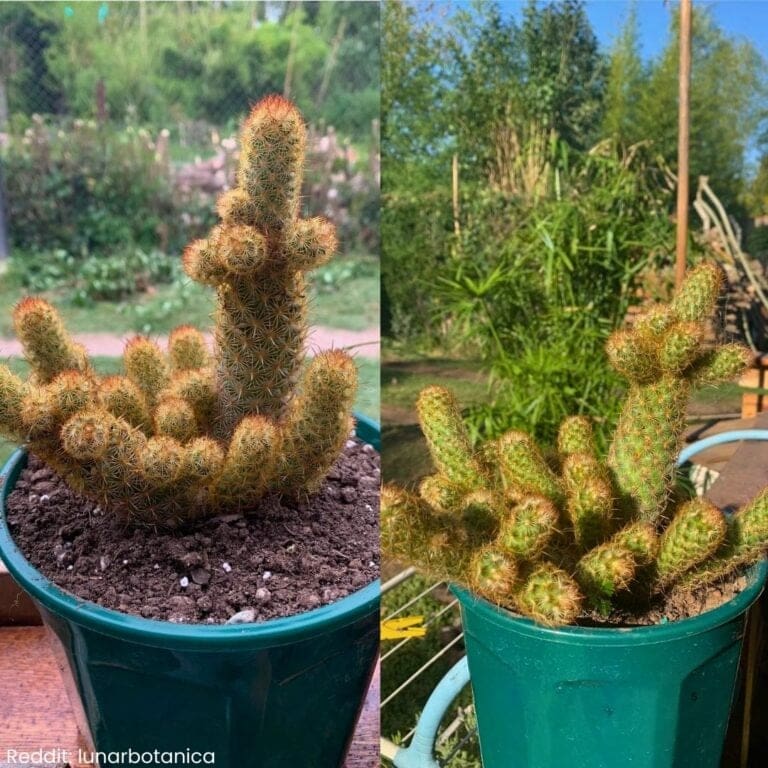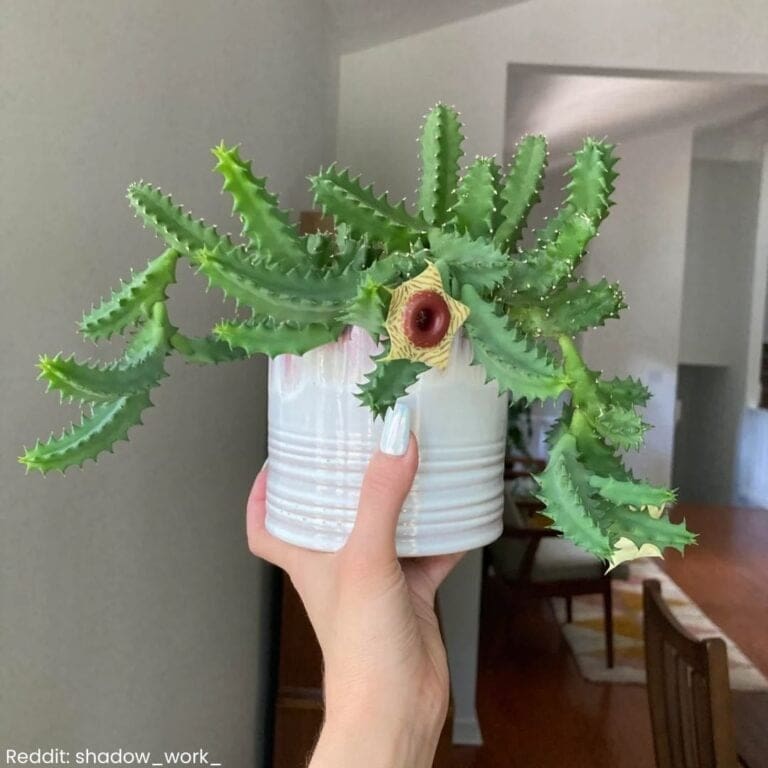Fishbone Cactus Care: Everything You Need To Know!
Are you curious about growing a unique houseplant? Let me introduce you to the Fishbone Cactus, a quirky plant with zig-zag stems that look just like a fish’s spine!
It’s not your everyday cactus, and it’s surprisingly easy to care for. You can have a lush green companion that brightens up any space without needing expert-level gardening skills. 🌿
Taking care of this cactus is a dream come true for busy people. All you need is indirect light, a bit of water, and some love!
It thrives in a bright spot but doesn’t like direct sun, which can scorch its funky stems.
Let the soil dry out between waterings, and you’re pretty much set. This plant doesn’t demand much but gives a lot back in charm.
Ever tried to propagate a plant? It’s a fun and rewarding experience!
With the Fishbone Cactus, you can do it easily. Just snip off a piece and stick it in some soil or water.
Imagine turning one quirky cactus into many. 🌵✨ Who wouldn’t want to fill their home with these delightful, fuss-free plants?
Please note: Simplify Plants is reader-supported. As an Amazon Associate, I earn from qualifying purchases made by our readers with no extra cost added to you all! Some links in the post are affiliate links and I get a commission from purchases made through links in the post.
Getting to Know Your Fishbone Cactus
The Fishbone Cactus has some unique characteristics and varieties. As a pet-friendly and easy-to-care-for plant, it adds charm to any home. 🏡 Let’s explore its origins and popular types.
Origin and Characteristics
The Fishbone Cactus, also known as Epiphyllum anguliger, is native to the rainforests of Mexico. It thrives in humid environments and lives on trees, getting its nutrients from the air.
Its distinctive zigzag pattern makes it quite the eye-catcher! 🌵
This plant loves bright, indirect light and enjoys a good soak followed by a dry spell.
Does your cactus look a bit droopy? It might need some water or a change in lighting.
Its blooms open at night and have a sweet fragrance, a feature not everyone gets to enjoy.
Common Varieties
Several Fishbone Cactus varieties have unique features.
One popular type is the Ric Rac or Zigzag Cactus, known for its bold, wavy leaves. It looks great in hanging baskets, where its stems can trail down beautifully. 😍
Another variety to check out is the Epiphyllum ‘Curly Locks’, which offers a fun twist—literally! Its curly stems add texture to any plant collection.
Lastly, the Queen of the Night steals the show with its stunning, large blooms. 🌙
Ever wonder how these varieties might look in your space? They each add a unique flair, so your Fishbone Cactus can be a standout feature in your home.
Essential Care Overview

Caring for a Fishbone cactus is rewarding and quite easy. It thrives with the right light, moisture, and temperature. Let’s jump into the specifics that can help your plant grow strong and healthy.
Lighting Requirements
I find that my Fishbone cactus loves bright, indirect light.
Think of it as the “Goldilocks” of light exposure, not too hot, not too dim—just right!
Direct sunlight can scorch its unique zig-zag leaves, while too little light makes it leggy and sad.
A spot near a north or east-facing window works wonders.
Have you ever wondered why your plant looks a bit droopy 🤔? Try tweaking where it sits for better light and watch it perk up 🌿.
Watering Techniques
Watering is where many of us might slip up. I’ve learned to water my Fishbone cactus sparingly.
The soil should be dry before adding more water. It hates sitting in soggy soil, which can lead to root rot.
A quick tip? Give it a good soak every few weeks during growing seasons and cut back in the winter.
Is your cactus thirsty? Look for slightly wrinkled leaves.
Ideal Temperature Range
My Fishbone cactus seems happiest in temperatures between 60-77°F (about 15-25°C).
It’s pretty chill and doesn’t fuss much as long as it stays within this range.
If the room temps get too low or drafty, it might sulk a bit 🌵. So, a cozy corner away from cold drafts or hot radiators is ideal.
Humidity Preferences
One of the perks is that my Fishbone cactus doesn’t crave high humidity.
It’s native to rainforests but has adapted well to average home conditions.
If the air feels too dry for me, like in winter, it might benefit from a gentle misting. A humidifier can be helpful too.
Have you noticed crispy edges on the leaves? That might be a sign of needing a bit more humidity.
Remember, it’s all about finding that sweet spot for these unique plants!
Planting and Soil Composition

When dealing with fishbone cactus, proper soil and planting methods are essential. This cactus thrives in the right soil mix and benefits from occasional repotting. Let’s dive into what makes the perfect setup for these unique plants. 🌵
Soil Type and Drainage
I always aim for a well-draining soil mix. Fishbone cacti appreciate soil that prevents water from sitting too long, which can lead to root rot. Mixing regular cactus soil with perlite or orchid bark is a good start.
Here’s a quick list of what I use:
- Cactus soil mix
- Perlite for drainage
- Orchid bark for acidity and airflow
Think about baking a cake—too dense, and it’s a flop. Too wet, and it’s soggy. The same goes for your cactus!
A light, airy soil mix is like a comfy bed for its roots.
Repotting Guidelines
Do fishbone cacti need fancy pots? Nope! Simple pots with drainage holes work great.
Repotting is necessary every 1-2 years or when roots peek out from drainage holes.
It’s kind of like when my shoes get too tight—time for a new pair!
To repot, I gently loosen the old soil and place the cactus in a new pot with fresh soil.
Make sure the new pot isn’t too much bigger—just one size up is enough. Avoid packing soil too tightly. Give it a little wiggle room.
Feel free to ask if this sounds doable—or do you have any tips for me? 😊
Feeding and Fertilization

Taking care of a fishbone cactus includes feeding it right. This involves using the right kind of fertilizer and sticking to a proper feeding schedule. It’s all about giving this quirky plant the nutrients it needs to thrive. Let’s dive right in! 🌿
Fertilizer Types and Use
For my fishbone cactus, I prefer a balanced, water-soluble fertilizer.
Something like a 10-10-10 or 20-20-20 NPK ratio works wonders. These numbers represent nitrogen, phosphorus, and potassium—the nutrients my cactus needs most.
I also like using cactus-specific fertilizers. They’re formulated just for succulents, so I know my cactus gets exactly what it needs.
These fertilizers are usually diluted with water, making them super easy to use.
Sometimes I throw in a bit of compost or worm castings for extra nutrition.
Have you tried this? It’s like giving a little treat to my plant!
Feeding Schedule
Feeding my fishbone cactus is something I do during its active growing season, from spring to early fall.
I usually fertilize every 4 to 6 weeks. This keeps it happy and healthy.
In the winter months, when growth slows down, I reduce feeding. The cactus doesn’t need as many nutrients then.
If you notice your cactus isn’t growing well, it might need more food.
Do you ever feel like your cactus is asking for a little snack? Keep an eye on those leaves; they’ll tell you a lot. 🌵
Growth and Pruning

Caring for a fishbone cactus involves understanding how it grows and how to prune it effectively. The plant displays unique growth patterns, and knowing the right way to prune can keep it healthy and looking its best. Let’s dive into the details! 🌿
Growth Patterns
The fishbone cactus, also known as the zig-zag cactus, grows with a distinctive pattern.
It’s a trail of leafy green stems shaped like a fish skeleton. These stems are soft yet robust.
In its natural habitat, it climbs trees, reaching about 3 feet in length. At home, you’ll notice its tendency to hang, making it perfect for hanging baskets!
It grows fast in spring and summer.
Does seeing these funky shapes make you smile too? 😄
Growth usually slows down in cooler months, but don’t worry—this is totally normal.
Make sure it gets bright, indirect light for vibrant growth. Direct sun may burn its leaves, so a bit of shade is perfect.
Remember, it’s all about creating that tropical vibe! 🌴
Pruning Techniques
Pruning is as simple as giving your fishbone cactus a haircut! ✂️
I usually prune mine to keep it tidy and promote healthy growth.
Use a sharp, clean pair of scissors. It’s easier and safer for the plant. Always cut just above a joint or node.
Snipping off any dead or damaged stems helps the cactus focus on growing fresh, healthy ones.
You can also prune to shape the plant. Want a fuller look? Trim longer stems back. It encourages the plant to get bushier and more lush.
Ever thought of creating new plants?
Take cuttings from the pruned pieces and root them in water or soil. It’s a fun way to share or expand your green family! 🌱
Pest Prevention
If you’ve got a fishbone cactus, keeping it pest-free is a top priority. Bugs like mealybugs and spider mites often attack these plants. There are ways to spot these invaders early and stop them from taking over. Let’s dive into some practical tips to protect your plant. 🪴🐜
Common Pests
Fishbone cacti are usually attacked by mealybugs and spider mites.
These pests love to hide in the leaves and feed on plant sap.
You might notice a sticky residue or even a cotton-like mass if mealybugs are present. Those sneaky mites can cause the plant to lose color or look weak.
Want to catch them early? I check under the leaves often. Finding these pests early makes them easier to handle.
If I spot them, I use a gentle spray of water mixed with a mild soap to wash them away.
Keep your eyes peeled. 👀
Preventative Measures
Prevention is key!
I always make sure my fishbone cactus has good air circulation to keep pests away.
Placing the plant in a spot with plenty of light helps as well. Bright light keeps it strong and more resistant to bugs.
I like to wipe the leaves gently with a damp cloth every once in a while.
This is like giving your cactus a little spa day! It removes dust and reduces places for pests to hide.
Also, keeping an eye on overall plant health is crucial. A healthy plant is tougher and more resilient.
Give it your best shot, and your cactus will thank you! 😊
Disease Management

Keeping your Fishbone cactus healthy involves knowing about common diseases and how to deal with them effectively. Here’s what I’ve learned from my own experience caring for this unique plant. 🌵
Common Diseases
Fishbone cacti can sometimes face problems like root rot and fungal infections.
Root rot is usually due to overwatering. It’s like giving your cactus too many baths. 😊
Fungal infections often appear as spots on the leaves. These can be brown or black and sometimes have a fuzzy texture.
I once noticed spots and had to act fast to keep my cactus happy.
Do you ever check your cactus for these signs? It can help catch issues early!
Treatment and Control
If you notice root rot, reduce watering immediately. Let the soil dry out.
You might want to repot the cactus in fresh, well-draining soil.
For fungal problems, try using a fungicide. It’s like medicine for plants!
Follow instructions carefully when using it.
Sometimes, simple solutions work wonders.
For example, make sure your cactus gets enough air circulation.
I found this tip handy: keep your plant in a spot where air can flow freely.
What’s your go-to trick for dealing with plant troubles? I’d love to hear! 🍀
Propagation Methods
Growing new fishbone cactus plants can be quite fun. I enjoy using cuttings and growing from seeds.
Both methods are pretty simple once you know the steps. Let’s dive in and see which method suits you best! 🌵
Cuttings
I find cuttings are a quick way to grow new plants.
Start by snipping a healthy stem from the cactus. Make sure it’s about 3 to 6 inches long.
Let the cutting dry for a day so it heals.
Next, I plant the cutting in a pot with well-draining soil. A mix of cactus soil and a bit of perlite works well.
Watering is essential, but sparingly!
Keep the soil slightly moist until roots form, usually in a few weeks.
Once rooted, the cutting grows happily with little care.
Bright, indirect light is best to keep it healthy.
I’ve found that cuttings often root faster if the pot has good drainage holes.
Have you ever tried this method? It feels like plant magic! 🌿
Seed Germination
Germinating seeds is another way to grow these cacti. It’s slower but rewarding!
I start by cleaning the seeds and soaking them in water overnight. This jump-starts the germination process.
Next, I place the seeds on top of a mix of cactus soil and sand.
I cover them lightly, just enough to keep them in place.
A tip is to mist the soil gently with water to keep it damp but not soggy. ☔
Warmth and humidity encourage growth, so I cover the container with a clear lid or plastic wrap. Placing it in a bright, warm spot helps a lot.
I’ve noticed germination can take a couple of weeks to a few months.
Growing from seeds feels like a patience test, but it’s delightful when tiny cacti start to appear! Have you tried it? 😄
Common Problems & Troubleshooting
Caring for a Fishbone cactus can be easy, but sometimes things go wrong. Look out for overwatering issues, leaf problems, and thin growth.
Let’s dive into some specifics. 🌵
Overwatering Signs and Solutions
I’ve learned that overwatering is the most common problem with Fishbone cacti.
If you see yellowing leaves or feel soggy soil, it’s a sign of too much water.
I can’t stress enough how important it is to let the soil dry out between waterings.
I’ve found that repotting with fresh soil helps if the roots are rotting.
Also, do you ever forget to water less frequently? Try setting reminders on your phone.
Cutting back on watering can save your plant from disaster.
Do you sometimes worry you’re drowning your cactus? It’s okay, it happens to all of us!
Leaf Problems and Remedies
Leaves turning brown or shriveled? This happened to mine once, and I panicked 🎨.
It’s usually a sign of too much or too little sun. Placing your cactus in bright, indirect light works best.
Sometimes, pests like spider mites move in. I use a gentle soap spray to keep them away.
What about those odd black spots?
Often, these are caused by fungal infections. I recommend trimming affected leaves and ensuring good airflow around the plant.
Have you noticed any spots before? Being proactive really helps!
Thin Growth
Ever wonder why your cactus seems weak and leggy? Mine did too!
It turns out thin growth often results from a lack of light. Moving your Fishbone cactus to a spot with more brightness can do wonders.
If your cactus leans or stretches, it’s reaching for more light.
Wondering how to thicken up the growth? Fertilize once a month during the growing season with a cactus-friendly fertilizer.
It’s like giving your plant a boost of energy! 🥤
You’ll see stronger and healthier growth in no time.
Do you have any other tips on solving these issues? Sharing stories and solutions makes plant care easier! 🌿
Frequently Asked Questions
I’ve noticed that taking care of a fishbone cactus is easier than you might think. The plant has specific needs when it comes to water, sunlight, and care routines like propagating and managing blooming.
Let’s dive into some common questions I often hear! 🌿
How often should I water my fishbone cactus?
I usually water my fishbone cactus every week during the growing season. In winter, it’s more like once a month.
The soil needs to dry out between waterings.
Is it necessary to provide sunlight for a fishbone cactus, and if so, how much?
Fishbone cacti love bright, indirect sunlight.
I place mine near a window where the sun can’t scorch it. If the leaves start looking pale, I know it’s time for more light! ☀️
What steps are involved in propagating a fishbone cactus?
Propagating is super easy!
I cut a healthy leaf segment, let it dry for a day, and then plant it in soil.
Keeping it moist but not too wet helps it grow roots quickly.
Can a fishbone cactus be grown outdoors, and what are the ideal conditions?
Yes, absolutely! If it’s warm where you live, like in zones 10-12, the cactus can thrive outdoors.
Just make sure it’s shaded from harsh afternoon sun.
Why is my fishbone cactus not blooming, and how can I encourage it to do so?
Blooming needs patience and the right conditions.
Reducing water in winter helps.
Also, I give it 12 hours of darkness each night before blooming season. That usually does the trick!
Is misting a beneficial practice for fishbone cactus care?
I mist my fishbone cactus when I notice the air is dry.
They like humidity, so this helps maintain their health, especially during dry winters!
Does fishbone cactus bloom?
Yes, it does! When it blooms, the cactus produces stunning, fragrant flowers.
I find it’s a beautiful surprise when they pop up! 🌸
Recommended Garden Supplies
| Product Image | Our Recommended Gardening Supplies | Check Offers! |
|---|---|---|
Top Top
Top
Top
Top
Top
Top
Top
Top | rePotme Houseplant and Tropical Classic Potting Soil Mix | Check Offer On Amazon |
 Top
Top
Top
Top
Top
Top
Top
Top | Espoma Organic Indoor Plant Food | Check Offer On Amazon |
 Top
Top
Top
Top
Top
Top
Top
Top | GooingTop LED Grow Light 6000K Full Spectrum Clip Plant Growing Lamp | Check Offer On Amazon |
 Top
Top
Top
Top
Top
Top
Top
Top | Soil Moisture Meter | Check Offer On Amazon |
 Top
Top
Top
Top
Top
Top
Top
Top | Govee Hygrometer Thermometer, Bluetooth Enabled! | Check Offer On Amazon |
 Top
Top | LEVOIT Humidifiers for Large Room(Best For Plants) | Check Offer On Amazon |
 Top
Top
Top
Top
Top
Top
Top
Top | Upgraded DIY Automatic Drip Irrigation Kit, 15 Potted Houseplants Support | Check Offer On Amazon |
 Top
Top
Top
Top
Top
Top
Top
Top | Stainless Steel Heavy Duty Gardening Tool Set | Check Offer On Amazon |
 Top
Top
Top
Top
Top
Top
Top
Top | Bonide Insecticidal Soap | Check Offer On Amazon |
 Top
Top
Top
Top
Top
Top
Top
Top | Bonide 32 oz Spray Neem Oil for Organic Gardening | Check Offer On Amazon |
 Top
Top
Top
Top
Top
Top
Top
Top | Garden Safe Fungicide | Check Offer On Amazon |







